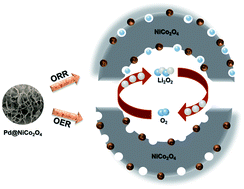Pd-Impregnated NiCo2O4 nanosheets/porous carbon composites as a free-standing and binder-free catalyst for a high energy lithium–oxygen battery†
Abstract
A novel free-standing air electrode with various structural and electrochemical merits was designed for a highly reversible lithium–oxygen battery. Interconnected NiCo2O4 nanosheets were grown almost perpendicular to the surface of carbon foam acting as a gas diffusion layer via a hydrothermal method combined with low temperature calcination and then decorated with palladium (Pd). Basically, this novel class of heterostructured catalysts consists of hierarchical nanosheets that can provide enough catalytic surface and open space, which is advantageous for oxygen or lithium ion transfer. In addition, the intrinsic porous structure of carbon foam better facilitates barrier-free oxygen transport and electrolyte penetration, while the introduction of Pd can modify the electronic structure of NiCo2O4, thereby enhancing electron transport all over the electrode. Because Pd incorporation also evolves the surface oxygen vacancies, which helps the discharge product (Li2O2) grow into a flower-like form, its formation or decomposition in the free-standing Pd@NiCo2O4 electrode could be rendered extremely reversible, finally realizing low charge over-potential, high discharge capacity (the maximum capacity reaches about 4000 mA h g−1) and long cycle life (extremely stable cyclic retention almost up to 100 cycles under the capacity limitation of 1000 mA h g−1).



 Please wait while we load your content...
Please wait while we load your content...